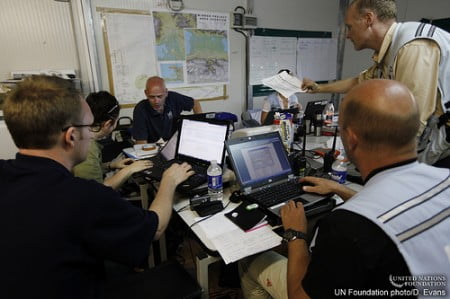Ed Note: January 12 marks the one year anniversary of the devastating earthquake in Haiti. Over the next few days we will be running a series of posts taking a look at progress over the past year and what still needs to be done to help get Haiti back on its feet.
By John Crowley
The disaster response operations of 2010 taught the humanitarian community hard lessons in how to communicate more effectively both with each other and with disaster affected communities. In reports reflecting on the year since the Haiti earthquake, key members of our community (see Internews and the ICT4Peace Foundation) are pointing to the need to adapt practices in the humanitarian response system to new realities, including policies to protect the security of data about vulnerable populations.
Turning these recommendations into implementable practices is going to require input from many stakeholders, including humanitarians from large agencies as well as representatives of the volunteer technical community. The United Nations Foundation & Vodafone Foundation Technology Partnership and UN Office for the Coordination of Humanitarian Affairs (OCHA) have partnered with the Harvard Humanitarian Initiative to conduct these consultations and propose both a framework developing this long-term dialogue and defining how new tools and practices can be integrated into the realities of the work in the field.
Consultations to gather both information and recommendations toward a framework that facilitates coordination between international humanitarian institutions and volunteer technical communities are ongoing, and will be presented in a report to be released this March. The report is intended to seed discussion between various stakeholders in emergency response and open a conversation through which practitioners and policy makers can discuss and seek solutions to technology-related emergency response challenges, including those seen in Haiti, Chile, Pakistan, and other emergency operations.
Based on dozens of initial interviews with staff from UN agencies, large NGOs, governments and the emerging community of humanitarian technologists and mappers, the Harvard team has distilled six of the core challenges, which are listed below.
The six findings so far include:
1. Mobile technologies and satellite communications are bringing everyone—humanitarian organizations, international institutions, volunteer technical communities, and the affected populations—ever closer together. More often than not, victims of disasters and conflicts have cell phones and can communicate via SMS in real time. The headquarters of various agencies are ever more closely connected to the operations in the field. And thousands of volunteers who until recently would have sent donations are now contributing mapping and crowdsourcing services.
2. As a result, information flows are accelerating, raising expectations around increasing the tempo of information management and coordination inemergency operations.
3. At the same time, the methods for data and information exchange are moving from document-based systems to flows of structured data via web services. This movement from the narration of ongoing events in long stretches of unstructured prose to streams of data in short, semi-structured formats require humanitarian staff to perform double duty. They are simultaneously working within an existing system based on the exchange of situation reports while filtering and analyzing high volumes of short reports arriving via SMS and web services.
4. Information Management in the humanitarian system is not tooled to compile, translate, and analyze the increased messaging from an affected population, the VTCs, or the demands of headquarters. For field staff who are working in difficult circumstances in technology-hostile environments, the sense of information overload is unprecedented and increasing.
5. Field staff and their managers are saying that the best method for integrating non-traditional information flows with humanitarian information management practices is to link new data flows into existing workflows and shared data standards. Adding new work flows will break the system.
6. As a result, stakeholders are calling for an interface between the humanitarian system and its cluster coordination mechanism and the various new sources of information—from the disaster affected community and the volunteer/humanitarian technologists.
Add your voice to the discussion by using the comment field below or email us at newhumanitarian-at-gmail-dot-com.
John Crowley is leading a team of researchers at the Harvard Humanitarian Initiative working on this report. Further information about the project is available here. This report will build on findings from the 2009 report New Technologies in Emergencies and Conflicts: The Role of Information and Social Networks.

